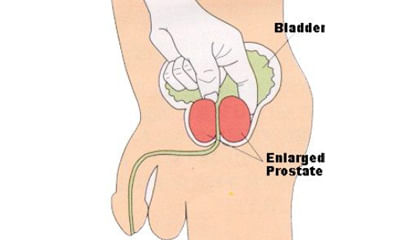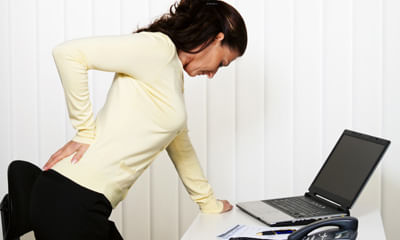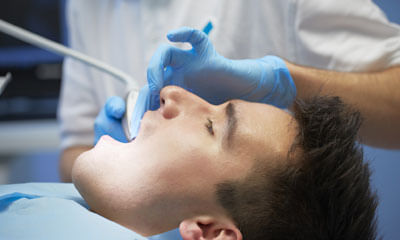Types Of Ear Operations
Sir my father age 79 year psa level found13 in routine checkup. After consultation of urologist/oncologist biopsy done i ...
Ask Free Question
Treatment depends on stage some types of prostate cancer grow slowly. In some of these cases, monitoring is recommended. Other types are aggressive and require radiation, surgery, hormone therapy, chemotherapy or other treatments. Supportive care palliative care and monitoring for changes or improvement medical procedure particle therapy, teletherapy, brachytherapy and radiation therapy surgery laparoscopic radical prostatectomy, radiosurgery, prostatectomy, radical retropubic prostatectomy and laparoscopic surgery medications hormone associated therapy, bone health, chemotherapy, hormone and urinary retention medication.
I am 50 years old working lady, I have a constant pain in month back and lower back, and hips whole back is very stiff. ...
Ask Free Question
From your symptoms, it appears you might be having a lumbar disc problem. Since your mentioned something about spondylolisthesis, I need to be sure of the same for which x-ray films need to be reviewed. In either case, core back muscle strengthening exercises under the supervision of a physiotherapist would be the mainstay of treatment in the initial period. However, exercises should be started only after reviewing your recent x-rays. This mode of treatment is successful in the majority of patients. If no relief is achieved one needs to be further investigated and another course of treatment modalities should be sought. Hope this information is helpful to you. Wish you a speedy recovery.
I am 45 years old male. I have got my 1st vaccine on april 30th, my 2nd vaccine is scheduled in a month. I have been dia ...
Ask Free Question
It depends on the type of vaccine you have taken. If the surgery is not an emergency, take the vaccine and after 4 weeks preferably plan for surgery. The vaccine will not complicate the surgery.
Hii, my wife got an appendix operation on the 6th of march and I want to know that in how many days we will be able to i ...
Ask Free Question
I am sorry to hear about your concern but will be happy to assist you. Your recovery time depends on the type of surgery you had. If you had laparoscopic surgery, you will probably be able to return to work or a normal routine 1 to 3 weeks after surgery. If you had an open surgery, it may take 2 to 4 weeks. If your appendix ruptured, you may have a drain in your incision. Let's connect over a call so that we can discuss your concern in details and make a suitable treatment plan for you.
How much time it will take for fixing fullest teeth after removing existing teeth? ...
Ask Free Question
Depends what options you are opting for for fixing teeth. As in removable, fixed or whatever you and your dentist have planned.
My mouth opening has reduced to about 2 fingers and I don't feel much burning sensation rest all is good only i've dropp ...
Ask Free Question
I am sorry to hear about your concern but will be happy to assist you. Trismus is a painful condition involving a reduction in the size of the mouth opening between the jaws. Most cases are temporary, and medications, physical therapy, and other treatments can often effectively alleviate trismus and reduce or prevent complications. Let's connect over a call so that we can discuss your concern in details and make a suitable treatment plan for you.
Sir, my father is seek from 1 month fever continues from 1 month medicine is not working doctors do all test but all tes ...
Ask Free Question
Kindly note that fever is a symptom of so many infections; inflamation; malignancy and metabolic problems. Doctors give symptomatic treatment with paracetamol etc to contol fever; at the same time they will try to find out the cause of this fever by clinical examination including history taking; and doing various lab and other type of investigations .once they succeed in finding out the cause of fever by all these --then they start the specific treatment------so kindly co-operate with your doctors with optimism that the exact cause will be found out soon and the specific treatment will reduce his problem---thank you for asking this important question.
Sir, I am suffering from constipation last three years. After appendicitis operation I feel this type problem. Intestina ...
Ask Free Question
1. Take home cooked, fresh light food. Take a lot of green vegetables n fruit. 2. Increasing the fibre in your diet 3. Increasing your fluid intake 4. Avoid fast foods, spicy n fried foods 5. Maintain active life style6. Curd is good for u.7. Avoiding straininghomeopathy has very encouraging results. Consult online with details.
I want to get my direct bilateral inguinal hernia operated. I want to undergo only meshless surgery. Is there any surgeo ...
Ask Free Question
I am sorry to hear about your concern but will be happy to assist you. Reports of 90 – 99% success rates are common. Mesh repairs, in many cases, offer a smaller chance of hernia recurrence rate than non-mesh repairs. Unfortunately, some repairs may lead to very high incidence of chronic pain, which can range from 5-15%. The key is to find a surgeon that performs a lot of hernia surgery. Let's connect over a call so that we can discuss your concern in details and make a suitable treatment plan for you.
I am 32 years old I am computer operator last 2 years I have back shoulder pain and neck pain and dizziness all time ple ...
Ask Free Question
Shoulder pain mobility exercises standing arm swings to do this exercise:1.Stand tall with your arms by your sides. 2.Engage your core and swing your arms forward until they’re as high as you can go. Make sure you don’t raise your shoulders. 3.Return your arms to the starting position and repeat. 4.Do this movement for 30 to 60 seconds. Shoulder pass-through to do this exercise: 1.Stand with your feet shoulder-width apart and your arms in front of your body. 2.Hold a stick, like a broomstick or pvc pipe, with an overhand grip. Your arms will be wider than shoulder-width. Make sure the stick or pipe is parallel to the floor. 3.Engage your core and slowly raise the broomstick or pipe above your head, keeping your arms straight. Only go as far as comfortable. 4.Hold the pose for a few seconds. 5.Return to the starting position. 6.Repeat 5 times. High-to-low rows to do this exercise: 1.Secure a resistance band to a sturdy object above shoulder height. 2.Kneel down on one knee and grab the band with the opposite hand. The other hand can rest at your side. 3.Pull the band toward your body while keeping your torso and arm straight. Focus on squeezing the shoulder blades together. 4.Return to the starting position and repeat. 5.Do 2–3 sets of 10 repetitions on each side. Reverse fly to do this exercise: 1.Hold a dumbbell in each hand. 2.Stand with your feet shoulder-width apart, knees slightly bent. 3.Engage your core and bend forward at the waist. Keep your back straight. Your arms will be extended. 4.Raise your arms away from your body. Focus on squeezing your shoulder blades together. Stop when you get to shoulder height. 5.Slowly return to the starting position and repeat. 6.Do 3 sets of 10 repetitions. Rotation with dumbbell o do this exercise: 1.Stand with your feet shoulder-width apart while holding a light dumbbell in your right hand. 2.Raise your arm so your elbow is at shoulder height. The front of your hand will be facing the ground. 3.Rotate your shoulder to bring your arm and weight up so your hand is raised toward the ceiling. 4.Slowly return to the starting position and repeat before changing sides. 5.Do 2–3 sets of 12 repetitions on each arm. Mobility stretches cross-arm stretch to do this stretch: 1.Stand with your feet slightly less than shoulder-width apart and bring your right arm up to a little less than shoulder height. 2.Place your left hand on your right elbow and gently pull your right arm across your body using the left hand to support your arm. 3.Hold this position for up to 30 seconds. 4.Repeat on the opposite side. 5.Do each side 3–5 times. Sleeper stretch to do this stretch: 1.Lie on the affected side. If you have no injury or pain, choose a side to start with. Your shoulder should be stacked underneath you. 2.Bring your elbow straight out from your shoulder and bend this arm, so your fingers are pointing toward the ceiling. This is the starting position. 3.Gently guide this arm toward the floor using the unaffected arm. Stop when you feel a stretch in the back of your affected shoulder. 4.Hold this position for up to 30 seconds. 5.Do 3 repetitions before changing sides. Doorway stretch to do this stretch: 1.Stand in a doorway with elbows and arms forming a 90-degree angle. Your feet should be in a split stance. 2.Bring your right arm up to shoulder height and place your palm and forearm on the doorway. 3.Gently lean into the stretch, only going as far as comfortable. 4.Hold the stretch for up to 30 seconds. 5.Change sides and repeat. Perform on each side 2–3 times. Chest expansion to do this stretch: 1.Stand tall with your feet together. 2.Hold the end of a towel or exercise band in each hand, with your arms behind your body. 3.Use the towel or band to help move your shoulder blades together and open your chest. This will cause you to look toward the ceiling. 4.Hold this pose for up to 30 seconds. 5.Repeat 3–5 times. Strenghtening exercises 1.pendulum stretch do this exercise first. Relax your shoulders. Stand and lean over slightly, allowing the affected arm to hang down. Swing the arm in a small circle — about a foot in diameter. Perform 10 revolutions in each direction, once a day. As your symptoms improve, increase the diameter of your swing, but never force it. When you're ready for more, increase the stretch by holding a light weight (three to five pounds) in the swinging arm. 2. Towel stretch hold one end of a three-foot-long towel behind your back and grab the opposite end with your other hand. Hold the towel in a horizontal position. Use your good arm to pull the affected arm upward to stretch it. You can also do an advanced version of this exercise with the towel draped over your good shoulder. Hold the bottom of the towel with the affected arm and pull it toward the lower back with the unaffected arm. Do this 10 to 20 times a day. 3. Finger walk face a wall three-quarters of an arm's length away. Reach out and touch the wall at waist level with the fingertips of the affected arm. With your elbow slightly bent, slowly walk your fingers up the wall, spider-like, until you've raised your arm as far as you comfortably can. Your fingers should be doing the work, not your shoulder muscles. Slowly lower the arm (with the help of the good arm, if necessary) and repeat. Perform this exercise 10 to 20 times a day. 4. Cross-body reachsit or stand. Use your good arm to lift your affected arm at the elbow, and bring it up and across your body, exerting gentle pressure to stretch the shoulder. Hold the stretch for 15 to 20 seconds. Do this 10 to 20 times per day. 5. Armpit stretch using your good arm, lift the affected arm onto a shelf about breast-high. Gently bend your knees, opening up the armpit. Deepen your knee bend slightly, gently stretching the armpit, and then straighten. With each knee bend, stretch a little further, but don't force it. Do this 10 to 20 times each day. Starting to strengthen as your range of motion improves, add rotator cuff–strengthening exercises. Be sure to warm up your shoulder and do your stretching exercises before you perform strengthening exercises. 6. Outward rotationhold a rubber exercise band between your hands with your elbows at a 90-degree angle close to your sides. Rotate the lower part of the affected arm outward two or three inches and hold for five seconds. Repeat 10 to 15 times, once a day. 7. Inward rotation stand next to a closed door, and hook one end of a rubber exercise band around the doorknob. Hold the other end with the hand of the affected arm, holding your elbow at a 90-degree angle. Pull the band toward your body two or three inches and hold for five seconds. Repeat 10 to 15 times, once a day. Shoulder exercises and stretches regular exercises and stretches can keep your shoulder strong and flexible. A few things to remember before swinging in to exercises: •stop any exercise if you have more shoulder pain. It may be too soon for you to try. •watch your form. Exercising incorrectly can also cause or worsen shoulder problems. •warm up, even before deep stretching. Light shoulder rolls, gentle movements, or even a warm shower are all ways to warm up your muscles before exercise and stretching. Pendulum stretch for range of motion•stand and bend at the waist. •let your arm on the injured side hang straight down. •keep your neck relaxed. •move your arm in a circle up to 20 times. •do once or more times in a day. Overhead shoulder stretch•sit or stand to do this shoulder stretch. •intertwine your fingers in front of you. •bend your elbows and raise your arms above your head. You can also place your hands on your head or behind it. •gently squeeze your shoulder blades together to move your elbows back. •continue for up to 20 repetitions. Repeat 5 to 10 times a day.Cervical spondylosis– chronic condition with radiating pain this is cervical pain (neck pain) and that's the reason the pain radiates until the shoulder blades. If you keep ice that would help and along side you can do hot water fermentation. You shall use cervical collar which would help you to reduce the radiating pain ie. Due to the nerve compression. You have to go for traction and also you can do ift. Please consult the near by therapist for quick relief. Since you have pain for more than 10 years it is suggestible to go for cervical muscle strengthening exercise. Use collar will definitely be helpful for him to maintain the good posture. And also cervical pillow can be used which might make you to have better posture of the shoulder neck and arm. Neck tilt: from the sitting position, tilt your head down so your chin touches your chest. Hold this position for 5 second s. Return to the starting position and repeat. Do this five times. Side-to-side neck tilt. From the same starting position, tilt you neck toward one shoulder, leading with your ear. Hold for 5 seconds and then return to the starting position. Do this five times on each side. Neck turn. Look straight ahead, then turn your head to one side, keeping your chin at the same level. Do this five times on each side. Neck stretch. Holding the rest of your body straight, push your chin forward, stretching your throat. Hold for 5 seconds. From the same starting position, push your chin backward and hold for 5 seconds. Do the forward and backward stretch five times each. If any of these exercises cause severe pain or weakness in your hands or arms, stop right away and talk with your doctor.We suggest you to wear cervical collar which will help you to improve the cervical angle and also it definitely helps you to improve the neck posture due to which your neck pain is triggered more. The importance of wearing cervical collar is to give good stability to the neck and also it definitely prevents you to have excess neck movements which makes the condition worse. If you wear cervical collar you cannot turn your neck as you like which itself will help you to have better functioning of the cervical spine. This cervical soft collar what we are suggesting for you is available at our clinic. If you want you can buy from us, if you are far away from chennai we can send you by courier. The reason why we are conveying you to buy from us is we can demonstrate over the videocall (using whatsapp) and also we can monitor you throughout when to wear it and how long to wear it. And also if you find any difficulty wearing the brace you can also revert back to us for few more suggestions and we can propose you good solution how to go about it. Neck pain many people experience neck pain because of poor posture and muscle strain. In these cases, your neck pain should go away if you practice good posture and rest your neck muscles when they’re sore. The most common types of mild to moderate neck pain usually respond well to self-care within two or three weeks. If you have minor neck pain or stiffness, take these simple steps to relieve it: apply ice for the first few days. After that, apply heat with a heating pad, hot compress, or by taking a hot shower. Exercise your neck every day. Slowly stretch your head in side-to-side and up-and-down motions. Use good posture. Avoid cradling the phone between your neck and shoulder. Change your position often. Don’t stand or sit in one position for too long. Get a gentle neck massage. Use a special neck pillow for sleeping. Short-term immobilization. Use a soft collar that supports your neck may help relieve pain by taking pressure off the structures in your neck. However, if used for more than three hours at a time or for more than one to two weeks, a collar might do more harm than good. Forward and backward tilt this can be done while you're seated or on your feet. Keep your moves slow and smooth. Start with your head squarely over your shoulders and your back straight. Lower your chin toward your chest and hold for 15-30 seconds. Relax, and slowly lift your head back up. Tilt your chin up toward the ceiling and bring the base of your skull toward your back. Hold for 10 seconds, then return to the start position. Repeat the set several times. Do it every day. Side tilt do this while standing, with your feet hip-width apart and arms down by your sides. Gently tilt your head toward your right shoulder and try to touch it with your ear. Stop when you feel the stretch. Don't raise your shoulder. Hold the stretch for 5-10 seconds, then return to the start position. Repeat on your left side. You can do several sets and work your way up to 10 repetitions. For extra stretch, put the hand on the same side of your tilted head on top of your head, and press lightly with your fingertips. Side rotation you can do this while seated or standing. Keep your head squarely over your shoulders and your back straight. Slowly turn your head to the right until you feel a stretch in the side of your neck and shoulder. Hold the stretch for 15-30 seconds, and then slowly turn your head forward again. Repeat on your left side. Do up to 10 sets. Press your palm against your forehead. Resist with your neck muscles. Hold for 10 seconds. Relax. Repeat 5 times. Do the exercise again, pressing on the sides (both the sides (right & left side) of your head. Repeat 5 times. Switch sides. Do the exercise again, pressing on the back of your head. Repeat 5 times.








